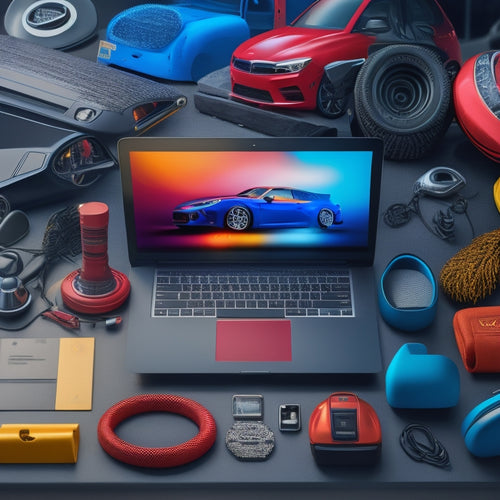
5 Best Ways to Integrate Scooters Into Transit
Share
You're on a mission to integrate scooters into your city's transit system. Start by developing scooter-friendly infrastructure, like dedicated lanes and traffic signals. Next, seamlessly connect scooters with public transit hubs by strategically placing parking and charging stations. Optimize routes and schedules using data analytics and machine learning algorithms. Incentivize multimodal transportation with tax breaks, mileage credits, and priority parking. Finally, deploy data-driven scooter parking solutions to identify high-demand areas and improve rider experience. By tackling these five key areas, you'll be well on your way to a seamless, efficient, and rider-centric scooter transit system - and that's just the beginning.
Key Takeaways
• Develop scooter-friendly infrastructure, including dedicated lanes, widened sidewalks, and traffic signals to enable efficient city navigation.
• Strategically locate scooter parking and charging stations near public transit hubs to reduce congestion and increase transit system efficiency.
• Leverage data analytics and machine learning algorithms to optimize scooter routes and schedules, providing a seamless user experience and identifying network bottlenecks.
• Offer incentives such as tax breaks, mileage credits, and priority parking to encourage the use of multimodal transportation and reduce reliance on personal vehicles.
• Implement data-driven scooter parking solutions, including smart sensors and virtual parking lots, to identify high-demand areas and improve the overall rider experience.
Scooter-Friendly Infrastructure Development
To guarantee seamless integration of scooters into transit systems, you'll need to develop dedicated scooter lanes, widening sidewalks, and installing scooter-specific traffic signals to facilitate smooth traffic flow. This infrastructure development is essential in promoting a harmonious coexistence between scooters, pedestrians, and vehicles.
By designating specific lanes for scooters, you'll reduce congestion and minimize the risk of accidents. Traffic calming measures, such as speed bumps and narrowed traffic lanes, will also help to regulate scooter speeds and create a safer environment for all road users.
Additionally, lane designation will enable scooters to navigate through the city more efficiently, reducing travel times and encouraging their adoption as a viable transportation option. By investing in scooter-friendly infrastructure, you'll create a more sustainable, efficient, and enjoyable transportation system that benefits everyone.
With careful planning and execution, you can create a model for scooter integration that sets a new standard for urban mobility.
Integration With Public Transit Hubs
By strategically locating scooter parking and charging stations near public transit hubs, you can create a seamless connection between scooters and public transportation, encouraging riders to combine both modes for their daily commutes. This integration won't only reduce congestion but also increase the efficiency of your transit system.
To take it a step further, consider appointing Hub Ambassadors who can assist riders with scooter parking, provide information on transit schedules, and offer guidance on combining scooter and transit trips. You can also introduce Transit Tokens, a loyalty program that rewards riders for using scooters and public transit together. This will incentivize riders to adopt a more sustainable and efficient way of commuting.
Scheduling and Route Optimization
As you design your scooter transit system, leveraging data analytics and machine learning algorithms to optimize routes and schedules can greatly reduce congestion and increase the overall efficiency of your network.
By analyzing real-time data on traffic patterns, scooter availability, and user behavior, you can identify areas of inefficiency and make data-driven decisions to improve your system.
Predictive modeling can help you anticipate peak usage times and adjust your fleet's deployment accordingly, ensuring that scooters are where they're needed most.
This proactive approach enables you to minimize congestion, reduce wait times, and provide a seamless user experience.
Additionally, real-time analytics can help you identify bottlenecks in your network, allowing you to make adjustments on the fly and optimize your system in real-time.
Incentivizing Multimodal Transportation
Regularly, cities that promote multimodal transportation options see a significant uptake in sustainable commuting habits, making it essential to incentivize users to combine scooters with other modes of transportation. By doing so, you can reduce traffic congestion, improve air quality, and enhance the overall commuting experience.
To encourage multimodal transportation, cities can offer various incentives. For instance:
| Incentive | Description | Benefit |
|---|---|---|
| Tax breaks | Offer tax deductions for users who combine scooter rides with public transportation. | Encourages users to opt for sustainable commuting habits. |
| Mileage credits | Reward users with mileage credits for using scooters for the first/last mile of their commute. | Increases the adoption of scooters as a viable transportation option. |
| Priority parking | Designate priority parking spots for users who arrive at transit hubs via scooter. | Reduces congestion and promotes a seamless shift between modes of transportation. |
| Discounted fares | Offer discounted fares for users who combine scooter rides with public transportation. | Makes multimodal transportation a more affordable and appealing option. |
| Gamification | Develop a rewards system that recognizes and rewards users for their sustainable commuting habits. | Fosters a sense of community and encourages users to continue using multimodal transportation. |
Data-Driven Scooter Parking Solutions
You can optimize scooter parking and reduce clutter in public spaces by leveraging data analytics to identify high-demand areas and strategically placing scooter parking corrals. By analyzing usage patterns and rider behavior, you can pinpoint areas where scooter parking is in high demand and allocate resources accordingly. This data-driven approach guarantees that scooter parking infrastructure is deployed where it's needed most, reducing congestion and improving the overall rider experience.
Smart sensors can be integrated into scooter parking corrals to track usage and provide real-time insights on parking availability. This data can be used to create virtual lots, allowing riders to reserve parking spots in advance and reducing the likelihood of overcrowding.
Frequently Asked Questions
How Do Scooter Companies Ensure Rider Safety in Heavy Traffic Areas?
As you navigate heavy traffic areas on your scooter, you wonder how companies guarantee your safety. They prioritize rider education on defensive riding and partner with cities to enhance traffic infrastructures, making roads safer for you.
Can Scooters Be Used by People With Disabilities?
As you ponder the possibilities, imagine a future where freedom of mobility knows no bounds. You'll be thrilled to know that scooters can be adapted for people with disabilities, offering accessible routes and adaptive designs to guarantee equal access to transportation.
Are Helmets Required for Scooter Riders in All Cities?
Checking urban regulations before riding is crucial, as helmet laws vary by city; while some cities require helmets for all scooter riders, others exempt certain age groups or leave it up to personal discretion.
How Do Cities Handle Scooter-Related Noise Pollution?
You're about to be bombarded by a cacophony of scooter noise, but fear not! Cities address scooter-related noise pollution by enacting strict Noise Ordinances and cleverly designing Sound Barriers to guarantee a peaceful coexistence with pedestrians.
Can Scooters Be Used on Sidewalks or Only on Roads?
You're wondering if scooters belong on sidewalks or roads? For pedestrian safety, it's essential to separate scooter paths from foot traffic, and thoughtful infrastructure design is key to making this work.
Related Posts
-

Top 10 Tips for Buying Car Accessories Online
When purchasing car accessories online, you should take proactive steps to avoid low-quality or incompatible products...
-

What You Need to Know About RV Solar Maintenance
When you're out on the road, your RV's solar panel system is your lifeline. But without regular maintenance, you're l...
-

10 Best Ways to Purify Urban Air With EVS
You're looking for ways to purify urban air with Electric Vehicles (EVs). You can start by incorporating EVS Air Filt...


